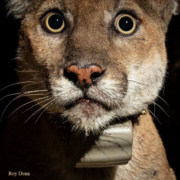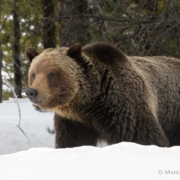The North American Brown Bear, ursus arctos–the grizzly. There are many names for this imposing, inspiring and iconic mammal, once proliferate across the continent, but now relegated to small islands of heavily invaded habitat in the Rocky Mountain West. And just as there are many names for the bear there are many perspectives about its value on the landscape.
The grizzly bear is a prime example of a creature defined by human beliefs, attitudes and values. If the perceptions that abound about grizzlies were each assigned a musical note, then we are in for a loud and discordant finale as the melody of recovery builds to the crescendo of the delisting process.
The story of the bear is a deeply embedded part of the cultures woven into our nation. Prior to human presence, the bear evolved as one of the most adaptable mammals on the landscape. Our earliest culture, that of the Native American, celebrated the bear, honoring his presence as an indication that they too could survive. The bears were treated with reverence and seen as a source of indefatigable power. Thus the spiritual significance of the grizzly to a people that have shared its path for eons cannot be underestimated.
Looking in from the outside, history illustrates the parallels between the way decision makers have treated both the bear and the indigenous people. Both once occupied broad swaths of the continent, both were regarded with fear, as threats to the immigrant white man and his interests, both were victims of widespread slaughter and both were eventually forced into arbitrary tracts of land to be preserved as artifacts of a bygone age. The eco-centric civilizations valued the bear not only for his physical body but also for his contribution to the rich lore that sustained them. The historical paradox extends to the fact that it was as late as the 1970’s that Indian Schools (the last was in Utah), which essentially whitewashed the richness of the native culture, were deemed redundant. No more cutting long lustrous Indian hair, no more cutting out the stories of animal totems and great spirits, no more cutting through the sensitive and beautiful belief systems that honored the earth and all who share it. The closure of the schools essentially marked the covert effort to ‘recover’ the right of the Native American to pursue and enjoy what little culture had been left to him, albeit on the islands of reservation land. It was also in the 1970’s that a partner emerged to walk the same path as the Indian…the Grizzly Bear!
Beaten back, exploited and victimized for the viewing pleasure of the mostly white traveling public, the great bear and the Indian conjointly received tacit approval to once again ‘be’ according to their nature and history. No longer a sideshow at garbage dumps, the bear, that icon of America, spanning the symbolic glitz of the California flag to the profound depth of native spirituality, would also be ‘recovered’. Just as the native sons and daughters of the Americas received a social reprieve that saw a reduction in ‘Wild West Shows’ and voyeuristic representation, so the native bear received a biological pardon. Science and not sociology would become the vehicle to transport the bear from near extirpation in the lower 48. There are many differences between science and sociology. With science, ironically, the human takes the credit for discovery of natural laws and the recovery of the bear illustrates how important that is as a definition of success. In a type of statistical absolution from the predominantly patrician scientific community, the bear has been declared ‘recovered’! Sociology also has a place in the picture of recovery, a place very similar to the Native American, a place of isolation. The Greater Yellowstone Ecosystem has become the Elba of the grizzly bear. Yet socially the value of the bear to ‘everyman’ has been played down. Even though our American God is money (Hence the reference on our currency-‘in God we trust’, refers not to a deity but to the green paper on which it is printed) the millions and millions of dollars generated by the social excitement of the now predictably visible bears have been played down to be almost buried in the magna, recently discovered below the home of the bears themselves. No, the social context is firmly centered on the desire of the state governments of Idaho, Montana and Wyoming to reward the consumptive users that have so patiently waited out the hard-knock moratorium on the opportunity to kill the bear for pleasure.
Science is often cited as a method devoid of emotion, or bias, but there can never be a non-emotional human activity. That is our nature in the same way that wildness is the nature of the bear, and spirituality and eco-symbolism predominate autochthonous cultures.
The Tribal representatives deserve to be part of the decision to declare the grizzly bear recovered. They know the bear’s story and have ‘walked ten miles in his shoes’ on the dangerous and intolerant journey that searches for an authentic place in the McCulture of America today.
http://www.kulr8.com/story/28949114/grizzly-delisting-rejected-by-tribes

 SMNRA
SMNRA

